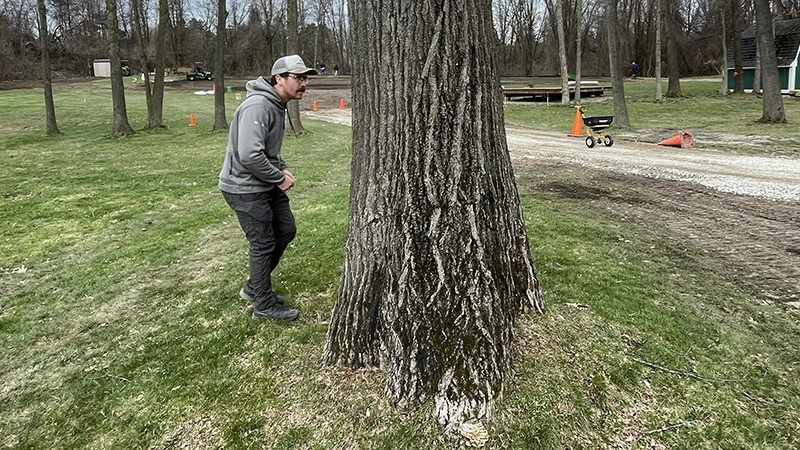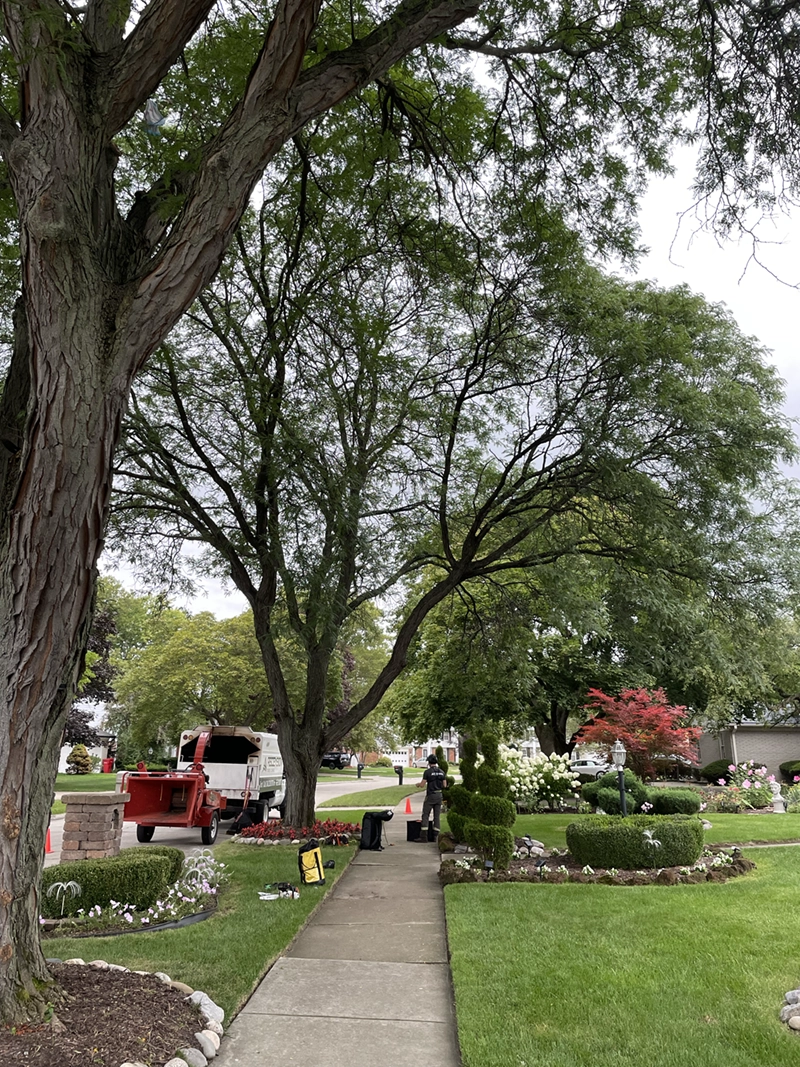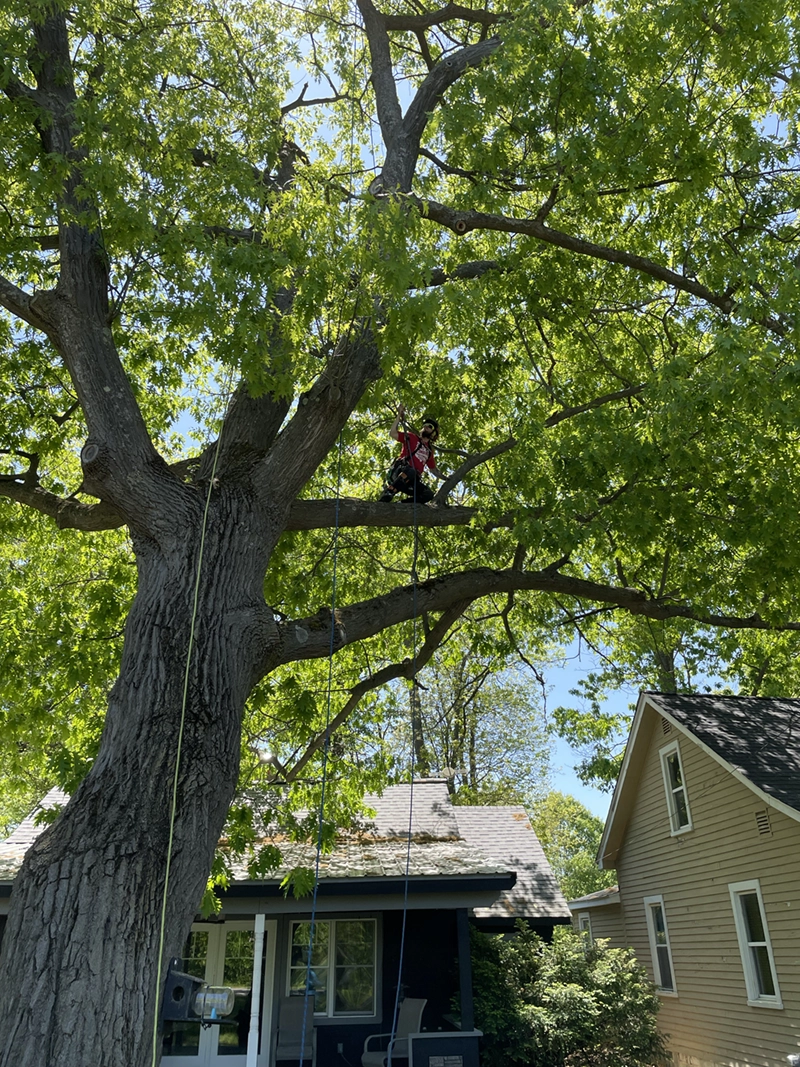Raising healthy trees is a rewarding accomplishment for Michiganders in Milford. Yet, there are various challenges that tree owners must face, including the notorious tree diseases common in our region. If something suddenly seems off on your tree, don’t ignore it. Please give it a closer look.
Let this guide help you connect the dots and confirm if your prized tree has fallen victim to one of the common tree diseases here in Milford, MI.

1. Oak Wilt
The mighty oak tree is a majestic sight in Michigan properties, but its natural strength is often not enough for the deadly oak wilt.
Spread through fungal infection, this disease is carried by sap-feeding beetles drawn to an oak’s open wound.
It can kill red oaks in just a few weeks and transfer onto nearby trees through grafted root systems.
Meanwhile, white oaks can survive for years carrying the disease. Regardless of the oak group, your infected tree should be addressed immediately to protect the surrounding trees.
The only way to stop the spread is by carefully cutting down and removing the tree from the site.
To prevent infection, pruning is best done in winter when the disease-carrying beetles are dormant.
Learn more about our oak wilt management services if you fear your trees are suffering from this nasty disease.
Signs of Oak Wilt
This disease can be recognized through the color of the leaves shifting from the top of the crown downwards.
Each leaf turns brown, bronze, or yellow from the tips to the middle and the stem. In a few weeks, you’ll see your tree shedding its discolored leaves.

2. Apple Scab
The crabapple tree’s captivating color is often threatened by apple scab.
This fungal disease is a common enemy of fruit trees in the rose family.
It may not be a deadly disease, but it ruins your tree’s produce and weakens your tree’s immunity to other diseases.
Apple scab spreads when the diseased leaves fall on the ground.
The fungus remains there over winter, then shoots spores into the air come spring.
The spore must remain moist on the plant for several hours to start an infection.
This is why the disease thrives during the wet seasons.
Cleaning the fallen leaves goes a long way in preventing the spread of apple scab.
For proactive protection, fungicide is an effective deterrent against this disease.
Signs of Apple Scab
If your tree is infected, you will find brown or black spots on the tree’s fruits and leaves.
Because this disease compromises the health of your tree, you will also notice that the fruits you harvest are fewer, smaller, and sickly.
3. Needle Cast
Needle cast is a foliage disease that targets spruce trees.
Since our blue spruce trees aren’t native to the region, growing outside of their natural domain leaves them susceptible to such illness.
The needle cast disease is spread by a fungus through the trees’ needles.
The spores are transferred from infected needles to the healthy needles of the same tree or a neighboring spruce through splashing water.
While it can be managed using fungicide, the removal of all infected trees is the best solution to prevent the spread of needle cast.
Signs of Needle Cast
The most common symptom of this disease is branch dieback, which begins with the inner lower branches before eventually encompassing the entire canopy.
It’s a slow, debilitating process that can span several years. When trees have this disease, you’ll often find tiny black spots dotting the infected needles.
This disease spreads when fungal spores move from infected to healthy needles—often through water splashing during rain or irrigation.
It begins as a slow decline, with dieback starting on the lower inner branches and gradually moving upward over several years.
Infected needles often display tiny black dots, a key indicator of the disease.
While fungicide treatments are available, severely affected trees may need to be removed to halt the spread.
That said, one of the best long-term defenses against needle cast, and many other tree health issues, is supporting the tree’s immune system from the ground up.
Healthy soil means stronger trees.
Because blue spruce is already under stress due to its non-native status, ensuring balanced soil nutrition and microbial life plays a critical role in disease resistance.
Our fertilization and soil amendment program helps build healthier root systems and more resilient trees, reducing the likelihood of future infections.
If you’re seeing signs of needle cast or want to prevent it before it starts, contact us to learn more about our proactive treatment options.

4. Tree Cankers
Canker disease can infect different tree species when they are wounded or stressed.
The pathogen enters your tree through an injury, and the fungal growth under the bark causes the infected area to weaken.
Like most fungal infections, tree cankers spread fast during wet or humid weather.
Avoiding pruning or wounding your tree under such weather is your best chance to prevent the spread of the disease.
If your tree already carries the disease, the infected branches may be removed during winter or dry weather.
Signs of Tree Cankers
You’ll identify tree cankers through sunken, swollen, cracked, or discolored surfaces on the tree bark.
Eventually, the disease causes branch dieback, which can lead to tree deformity or death.
5. Anthracnose
Deciduous trees in Michigan often fall victim to Anthracnose.
While not deadly, this fungal disease may chip away at your tree’s defenses against the other, deadlier diseases out there.
Much like the other fungi on this list, Anthracnose is often spread through wind and rainwater.
This makes the wet season a playground for the fungus to spread the infection further.
To put a stop to this infection on your property, your tree’s dead twigs should be pruned, and the fallen leaves should be cleaned up properly.
Signs of Anthracnose
The tree’s infected leaves will turn brown from dead spots, and its foliage will fall.
You will find patches of brown or black discoloration on the leaves of your tree. In severe cases, the twigs die, and cankers may appear on the tree trunk and limbs.
Prevent Tree Diseases with Plant Health Care
Most common tree diseases can be costly to manage.
Other times, treatment options are non-existent, and you don’t have a choice but to resort to a complete tree removal.
Even removing the infected trees will require extra caution because fungal spores can become airborne.
The best way to fight Michigan’s tree villains is through preventive measures.
This is where Plant Health Care (PHC) comes in.
PHC is the proactive approach to plant and tree care. Instead of taking action when signs of disease show up, you cultivate healthy trees with a strong resistance.
This is done by working with a tree care professional who will create a PHC program for you and provide the tree care services that will fulfill and exceed your tree’s needs.
The Ascension Tree Care Advantage
Ascension Tree Care is the trusted tree care company serving Oakland County, Michigan, including Milford and the surrounding areas.
Our ISA-certified arborists are equipped with extensive arboricultural knowledge and local experience to know precisely what your trees and plants need.

If you need seasoned tree experts as your plant healthcare partners, we’re here to serve.
Learn more about what plant health care means and how it keeps your landscape protected.
